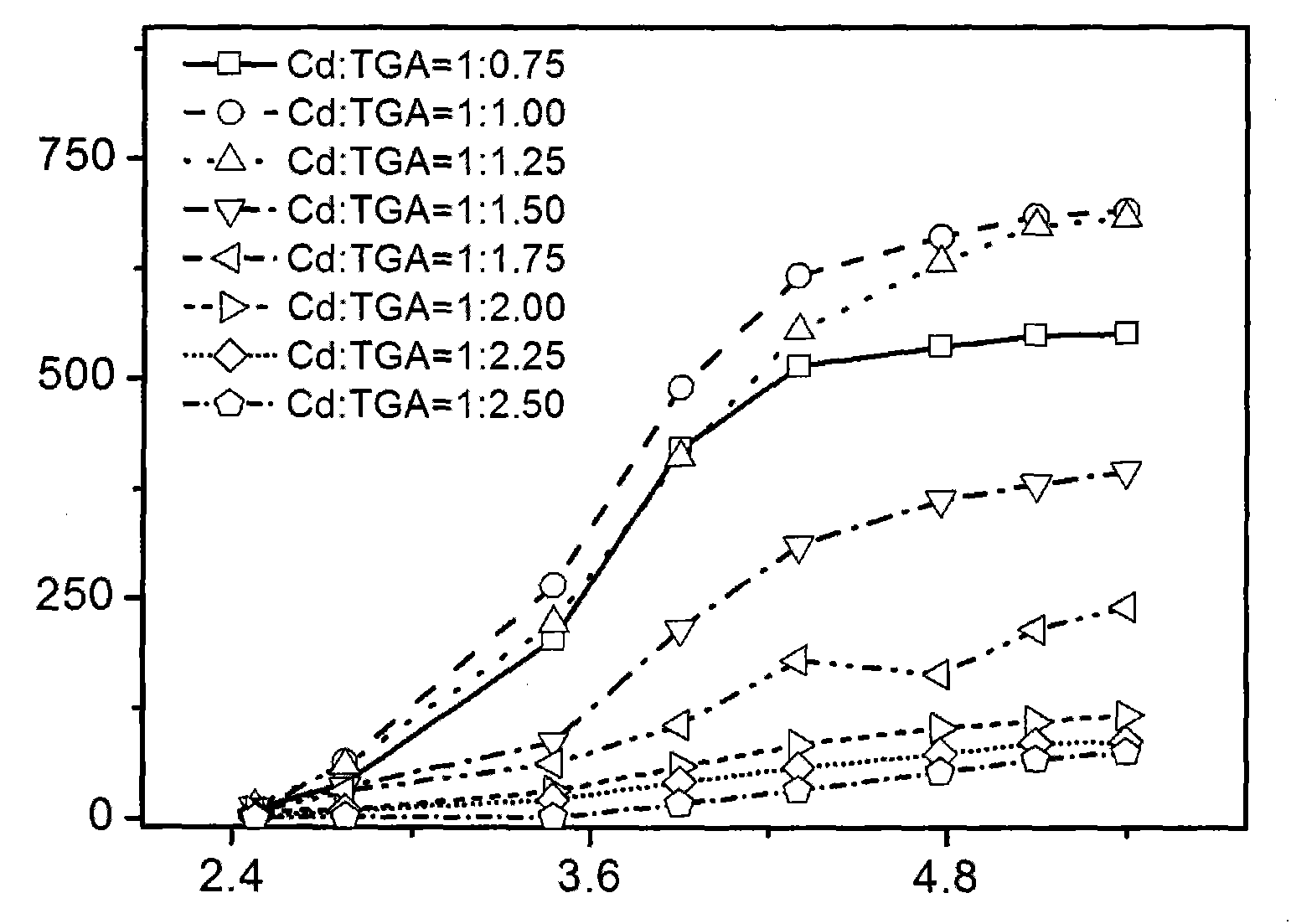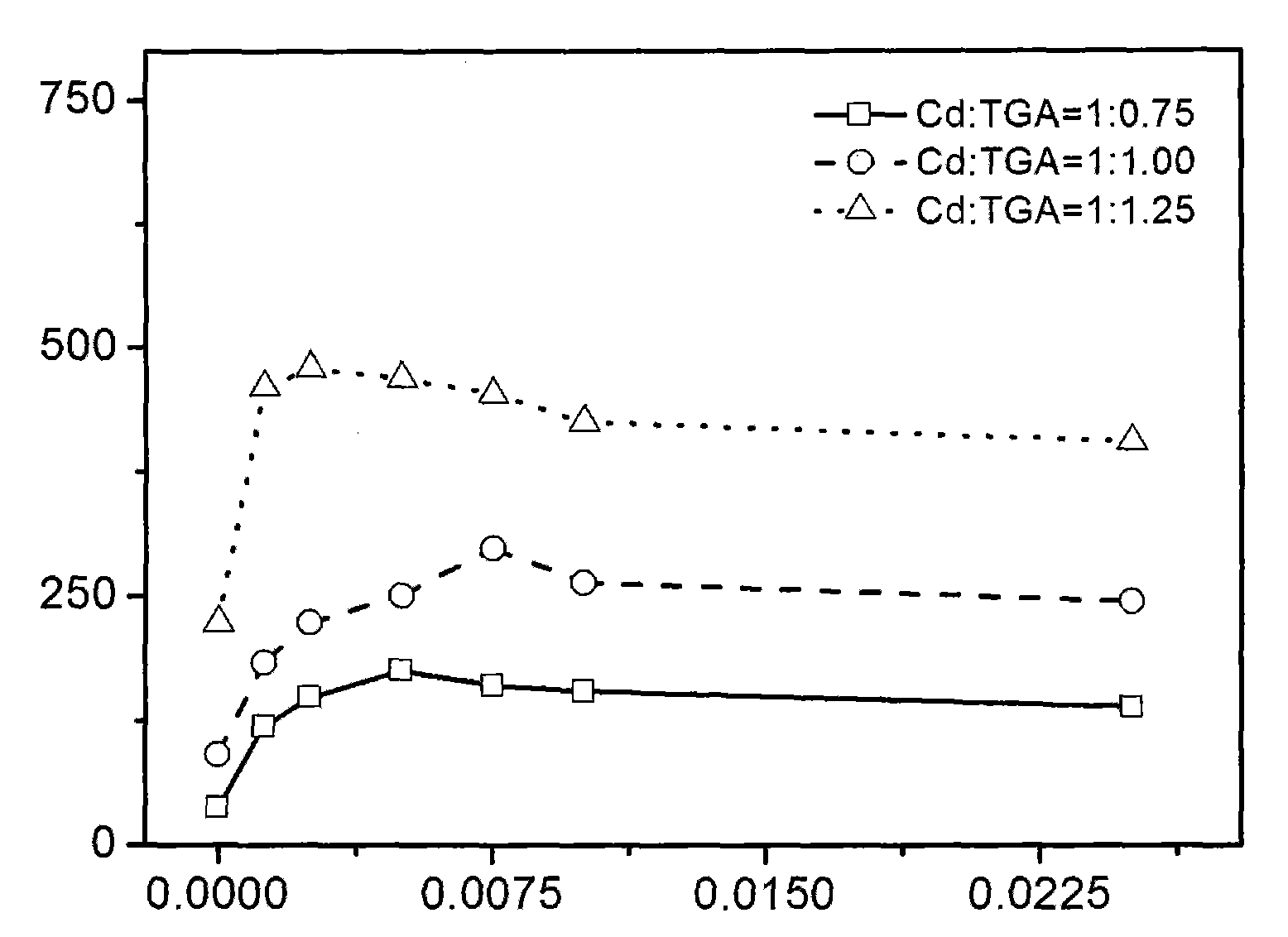Method for determining activity of acetylcholin esterase by using bifunctional quantum dot sensor system
A technology of acetylcholinesterase and thioacetylcholine, which is applied in the field of analytical chemistry, can solve problems such as unfavorable quantum dot material properties, limited sensitivity improvement space, and complicated reaction steps, and achieves reduced experimental costs, high sensitivity and responsiveness, and simple methods Effect
- Summary
- Abstract
- Description
- Claims
- Application Information
AI Technical Summary
Problems solved by technology
Method used
Image
Examples
Embodiment 1
[0030] Synthesis of NaHTe precursor: A 10mL round-bottomed flask is connected to sealed water through a small needle and rubber tube, and 0.2g NaBH 4 And 0.16g Te powder were added to the sealed flask, and N 2 Then inject 3.0 mL of deoxygenated distilled water under an ice bath, and react for 6 hours. The resulting clear liquid is the Te source for the next step of quantum dot synthesis;
[0031] Synthesis of dual-function TGA-CdTe quantum dots: weigh 0.23g CdCl 2 After dissolving in 100mL distilled water, add TGA, Cd 2+ The molar ratio between TGA and TGA is 1:0.75, the pH of the solution is adjusted to 11.2 with 0.1M NaOH, and N is introduced 2 30min, quickly inject the newly synthesized NaHTe solution, Cd 2+ : HTe - The molar ratio is 1:0.5, the solution is in N 2 Reflux at 100°C for 4hr under protection. The obtained quantum dots are filtered through a 0.45μm filter membrane and then passed through N 2 save.
[0032] Prepare 0.2M NaAC-HAC with different pH buffers, pH 3.5, 4.0, ...
Embodiment 2
[0037] Synthesis of NaHTe precursor: A 10mL round-bottomed flask is connected to sealed water through a small needle and rubber tube, and 0.2g NaBH 4 And 0.16g Te powder were added to the sealed flask, and N 2 Then inject 3.0 mL of deoxygenated distilled water under an ice bath, and react for 6 hours. The resulting clear liquid is the Te source for the next step of quantum dot synthesis;
[0038] Synthesis of dual-function TGA-CdTe quantum dots: weigh 0.23g CdCl 2 After dissolving in 100mL distilled water, add TGA, Cd 2+ The molar ratio between TGA and TGA is 1:1.25, use 0.1M NaOH to adjust the pH of the solution to 11.2, and pass N 2 30min, quickly inject the newly synthesized NaHTe solution, Cd 2+ : HTe - The molar ratio is 1:0.5, the solution is in N 2 Reflux at 100°C for 4hr under protection. The obtained quantum dots are filtered through a 0.45μm filter membrane and then passed through N 2 save.
[0039] Prepare 0.2M NaAC-HAC with different pH buffers, pH 3.5, 4.0, 4.5, 5.0, 6....
Embodiment 3
[0044] Synthesis of NaHTe precursor: A 10mL round-bottomed flask is connected to sealed water through a small needle and rubber tube, and 0.2g NaBH 4 And 0.16g Te powder were added to the sealed flask, and N 2 Then inject 3.0 mL of deoxygenated distilled water under an ice bath, and react for 6 hours. The resulting clear liquid is the Te source for the next step of quantum dot synthesis;
[0045] Synthesis of dual-function TGA-CdTe quantum dots: weigh 0.23g CdCl 2 After dissolving in 100mL distilled water, add TGA, Cd 2+ The molar ratio between TGA and TGA is 1:1.75, use 0.1M NaOH to adjust the pH of the solution to 11.2, and pass N 2 30min, quickly inject the newly synthesized NaHTe solution, Cd 2+ : HTe - The molar ratio is 1:0.5, the solution is in N 2 Reflux at 100°C for 4hr under protection. The obtained quantum dots are filtered through a 0.45μm filter membrane and then passed through N 2 save.
[0046] Prepare 0.2M NaAC-HAC with different pH buffers, pH 3.5, 4.0, 4.5, 5.0, 6....
PUM
 Login to View More
Login to View More Abstract
Description
Claims
Application Information
 Login to View More
Login to View More - R&D Engineer
- R&D Manager
- IP Professional
- Industry Leading Data Capabilities
- Powerful AI technology
- Patent DNA Extraction
Browse by: Latest US Patents, China's latest patents, Technical Efficacy Thesaurus, Application Domain, Technology Topic, Popular Technical Reports.
© 2024 PatSnap. All rights reserved.Legal|Privacy policy|Modern Slavery Act Transparency Statement|Sitemap|About US| Contact US: help@patsnap.com










